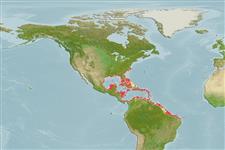>
Gobiiformes (Gobies) >
Eleotridae (Bully sleepers)
Etymology: Dormitator: Latin, dormire = to sleep (Ref. 45335); maculatus: Specific name means 'spotted' or 'stained'..
More on author: Bloch.
Environment: milieu / climate zone / depth range / distribution range
Ecologia
marino; acqua dolce; salmastro demersale; amfidromo (Ref. 51243). Tropical; 17°C - 35°C (Ref. 35237); 37°N - 5°S
North to South America: along the Atlantic slope from North Carolina (USA) to southeastern Brazil.
Size / Peso / Age
Maturity: Lm ? range ? - ? cm
Max length : 70.0 cm TL maschio/sesso non determinato; (Ref. 26340); common length : 14.5 cm TL maschio/sesso non determinato; (Ref. 12193)
Spine dorsali (totale): 1 - 7; Raggi dorsali molli (totale): 9-15; Spine anali 0-1; Raggi anali molli: 9 - 10. A short stubby fish with a conspicuously flat head (Ref. 26938).
Facultative air-breathing in the genus (Ref. 126274); Adults inhabit marshes, muddy ponds and channels with a salinity range of 0 to 21 ppt (Ref. 7251), up to 38.4 ppt in some cases (Ref. 97140). Mostly found in fresh water but also in brackish mangrove areas. They ascend upstream but remain in the lower reaches. Sexually mature after one year. Gonads develop during the dry season. Average size at maturity is 5.1 cm for males, 4.5 cm for females. Omnivorous, adults feed mainly on plants, sediments and invertebrates. They undergo coloration change during reproduction, carrying out a complex nuptial parade. Adults guard the nest. Egg is 0.3 mm, incubation time is 11 to 16 hours at 27°C (Ref. 35237).
Life cycle and mating behavior
Maturità | Riproduzione | Deposizione | Uova | Fecundity | Larve
Robins, C.R. and G.C. Ray, 1986. A field guide to Atlantic coast fishes of North America. Houghton Mifflin Company, Boston, U.S.A. 354 p. (Ref. 7251)
IUCN Red List Status (Ref. 130435)
Threat to humans
Harmless
Human uses
Warning: mysqli::__construct(): (08004/1040): Too many connections in /var/www/html/includes/func_getlabel.php on line 46
Can't connect to MySQL database (fbapp). Errorcode: Too many connections
